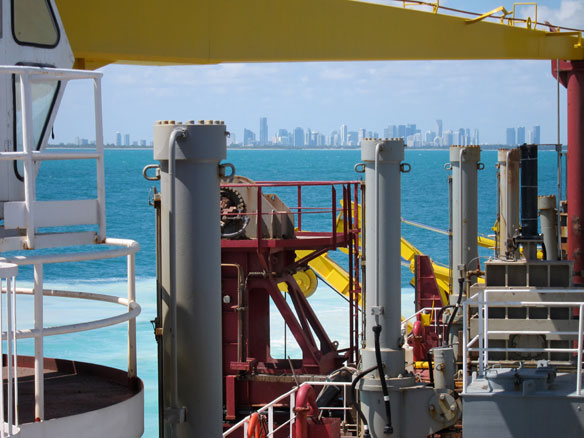On-board a sand dredger, offshore Miami. Photograph courtesy of “Sand Wars” Award-Winning Filmmaker: © Denis Delestrac (©-2013).
“Beach nourishment projects have become commonplace along the US East and Gulf Coasts. These projects have immediate environmental impacts through burial of nearshore habitat and increased turbidity during project placement.The cumulative environmental impacts of doing this repeatedly on the same beach while conducting projects from Maine to Texas is unknown. But, we should be concerned. ” —Robert S. Young, PhD, Director, Program for the Study of Developed Shorelines, Professor, Coastal Geology, Western Carolina University
Excerpts;
Sand-starved Dania Beach is getting an emergency infusion of that gritty stuff that gets washed away every year.
Sand by the truckload is being brought in and deposited on the northern half of the beach near the pier…
Also of Interest:
Florida has spent more than $100 million pouring more sand onto beaches in the past three years. Is it time to wave a white flag? Sun Sentinel (06-08-2018)
In South Florida’s war against the tides, it may be time to recognize that discretion is the better part of valor. For the past 70 years, the state of Florida has spent more than $1.3 billion on packing sand onto eroding beaches…
Column: High-rises spell the end for Florida beaches; By Orrin H. Pilkey and J. Andrew G. Cooper; Tampa Bay (07-25-2017)
Floridians are becoming more attuned to sea level rise and more familiar with nuisance flooding related to the rising sea. However, we believe there is less recognition that by century’s end it is likely that most of Florida’s major beaches will be permanently gone…
Gone with the wind: storms deepen Florida’s beach sand crunch; Reuters (02-16-2018)
Costs of so-called beach renourishments are a fraction of the total, measured in hundreds of millions of dollars, but the effort is crucial for Florida’s $67 billion tourism industry. And while sand needs are surging, there is not enough to go around…
Sand washes away as quickly as it can be dumped, Bathtub Beach, FL, TCPalm News (11-17-2017)
Between 2004 and 2014, some $13.6 million was spent on beach renourishment in Martin County, Florida. About $7.1 million came from local funds — your tax dollars. In the past two years, more than $6 million from a variety of sources has been spent to renourish and restore dunes at Bathtub Beach alone…
Florida is drowning. Condos are still being built. Can’t humans see the writing on the wall? Guardian UK (02-15-2018)
People tend to respond to immediate threats and financial consequences – and Florida’s coastal real estate may be on the cusp of delivering that harsh wake-up call…
Factbox: Sifting Through U.S. Beach Sand Numbers; Reuters (02-16-2018)
Can Adding Sand to Beaches Save Them? How Stuff Works (04-13-2018)
The question is, can beach nourishment keep up with the ever-increasing forces of climate change or, like Sisyphus forever pushing his boulder up the hill, is adding sand to beaches an expensive, temporary fix to a long-term problem?..
“A Never-Ending Commitment”: The High Cost of Preserving Vulnerable Beaches; ProPublica (09-27-2018)
The U.S. government pays to dump truckloads of sand onto eroding beaches, in a cycle that is said to harm ecosystems and disproportionately benefit the rich…
A look at the billions of dollars behind beach renourishment: Is it worth it? WMBF (10-15-2018)
The end of the world’s most famous beaches; By Orrin H. Pilkey and J. Andrew G. Cooper (07-2017)
All over the world there are beaches lined with condos, hotels, restaurants and the like, in high-rise buildings (i.e., skyscrapers). Such beaches are generally the nation’s premier tourist areas, important to the local people and the local economy and prime spots for national and international vacationers. The powers that be in most of these places continue high-rise construction and seem oblivious of the sea level rise…
Sand, Rarer Than One Thinks: A UNEP report (GEA-March 2014)
Despite the colossal quantities of sand and gravel being used, our increasing dependence on them and the significant impact that their extraction has on the environment, this issue has been mostly ignored by policy makers and remains largely unknown by the general public.
In March 2014 The United Nations released its first Report about sand mining. “Sand Wars” film documentary by Denis Delestrac – first broadcasted on the european Arte Channel, May 28th, 2013, where it became the highest rated documentary for 2013 – expressly inspired the United Nations Environment Programme (UNEP) to publish this 2014-Global Environmental Alert.
Sand Wars, An Investigation Documentary, By Award-Winning Filmmaker Denis Delestrac (©-2013)
“Sand is the second most consumed natural resource, after water. The construction-building industry is by far the largest consumer of this finite resource. The traditional building of one average-sized house requires 200 tons of sand; a hospital requires 3,000 tons of sand; each kilometer of highway built requires 30,000 tons of sand… A nuclear plant, a staggering 12 million tons of sand…”—Denis Delestrac -(©-2013)









